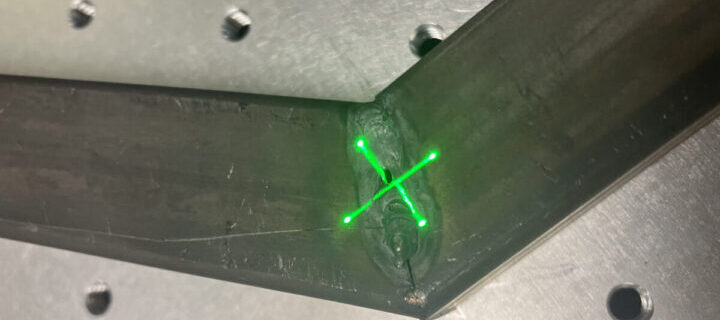
When it comes to improving weld quality and accelerating welding operations, guidance from laser projection systems is a mature, proven technology. In fact, for more than 15 years LASERGUIDE laser projection has been used in harsh shipyard environments to provide efficient, reliable welding support for all Virginia-class submarines.
To raise both quality and speed of welding operations today, laser projection offers a great starting point. It accelerates and ensures the quality of weld setup and execution. But what about weld inspection? To make your welding operations even more efficient and accurate, let’s discuss what LASERVISION will do to give you a competitive edge.
Achieving weld quality through multiple steps
Where and when do quality management activities take place in a welding operation? First is setting up the pieces to be welded together, as well as any fixtures or jigs. They must be positioned correctly relative to each other and secured in place. On larger works-in-progress, especially where setup involves hoists or cranes, any positioning errors lead to time-consuming and costly repositioning efforts.
But even before discovering that you have to reposition a jig or piece to be welded, you must first recognize that it is out of place. So the first round of inspection activities must be performed before any actual welding. Checking the setup may involve manually positioning physical templates or using devices for critical measurements, and either of these adds considerably to cycle time.
After the weld is executed, the next round of inspections must ensure weld quality. Characteristics of a high-quality weld include:
- Even distribution of weld material between the two joined pieces
- Absence of slag and other waste materials
- Absence of porosity and pinholes
- Correct weld shape and dimensions, including flatness and convexity or concavity
Current “best practices” for these quality checks are visual inspections by trained human inspectors, who are typically equipped with handheld fillets, a magnifying glass, flashlight, tape measure and calipers. These manual inspections greatly lengthen cycle time (and the portion of it spent on nonvalue-added tasks) and they are subject to human error. They also require your company to keep up with inspector training, which is made all the more difficult with the current trend of skilled staff leaving the workforce.
Another difficulty in weld quality management is what digitalization experts call “siloed systems.” The design and engineering data that establishes weld specifications must be communicated to the shop floor, and this is no simple matter if your CAD/CAM systems are isolated from the digital and automation systems in the factory. Additionally, your staff must glean the relevant specifications from computer files or paper documents, then correctly interpret them to reliably perform accurate setup, welding and inspections.
All this means that today’s best practices result in time-consuming and error-prone weld quality management. Oddly, this is good news for forward-looking companies. You have an opportunity to gain the advantages of model-driven digital guidance and inspection technologies now available.
Applying LASERVISION to welding operations
If your shop relies on manual or paper-driven weld quality management activities, then upgrading to laser projection will bring proven model-driven efficiencies to your setup operations. LASERGUIDE (or MicroLASERGUIDE for mobile operations or confined spaces) reads CAD data and accurately projects in three-dimensional space the correct locations for fixtures, jigs and work pieces. Reducing both cycle time and errors, laser projection offers you a great return on investment and ongoing savings into the future.
If you are already using laser projection or if you are ready to digitalize both guidance and inspection operations, you’ll gain a great competitive edge and rapid ROI with LASERVISION’s proven technology. LASERVISION uses CAD data both to project accurate laser patterns and to capture ultra-high resolution images for inspection tasks. The system’s image analysis algorithms, generated by artificial intelligence, verify weld quality with the same kind of capabilities that facial recognition software offers today.
Any flaws or defects detected by LASERVISION are easy to find and rework in real time. Like an automated version of a presenter’s laser pointer, the system uses laser projection to quickly guide operators to the suspect location for immediate correction.
Going digital
In the welding industry, it makes sense that some operations will always be best handled manually by your staff. Setup activities, for example, benefit from the greater mobility and better visual and tactile senses people have. As a result, robotic pick-and-place systems are more cost-effective than manual setup only on high-volume mass production lines. For any of your activities that will continue to be performed manually, digital technology like laser projection accelerates task completion and minimizes human error, as well as rework and scrapping of valuable works-in-progress.
On the other hand, manual inspection is no longer a best practice now that proven, real-time automatic inspection technology is ready to reduce inspection time by 90 percent or more, with nearly 100 percent inspection accuracy. Contact us today to discuss more specifically how your welding operations will benefit from laser guidance and automatic inspection.
